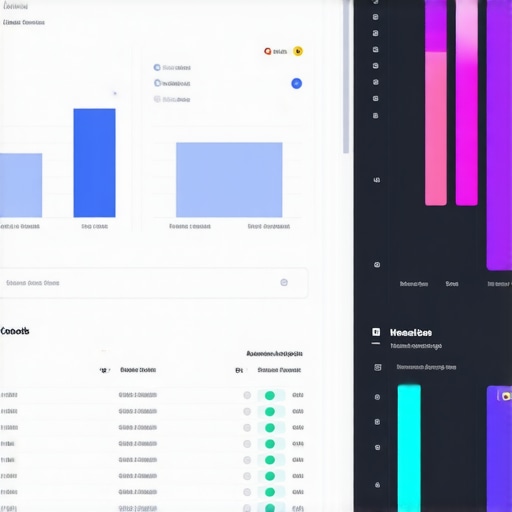My Journey Through the Maze of Google Business Profile Troubles
Just a few months ago, I found myself locked out of my Google Business Profile, facing a sudden drop in visibility and rankings. It felt like my online presence was slipping away, and I knew I had to act fast. This personal experience ignited my quest to understand the best ways to recover from ranking issues and restore my profile’s health, especially with the ever-increasing competition in local SEO.
Unveiling the Secrets Behind Effective Ranking Solutions
In my research and experimentation, I discovered that tackling ranking issues requires a strategic approach. One of the most critical steps is identifying whether your profile has been affected by spam or malicious edits. The GBP spam fix strategies are essential to clean up your profile before attempting recovery. I learned that tools like Google’s own Google My Business support can help verify if your profile has been compromised, guiding you on the right recovery steps.
How Do I Know When My Profile Is Truly Recovered?
What indicators should I look for to confirm my profile’s health post-recovery?
After applying various recovery techniques, I kept a close eye on key metrics such as search visibility, customer inquiries, and reviews. When these metrics begin to improve consistently, I consider my profile recovered. Additionally, monitoring the profile’s ranking for core local keywords provides tangible evidence of success. For deeper insights, I referred to comprehensive guides like top profile recovery tips for 2024, which offer step-by-step solutions for a seamless recovery process.
If you’re struggling with similar issues, I encourage you to share your experiences or ask questions in the comments. Together, we can navigate this complex landscape and ensure our profiles shine in 2024!
Are You Overlooking These Key Metrics to Confirm Your Profile’s Recovery?
Many local SEO experts emphasize the importance of monitoring search visibility, reviews, and customer inquiries as primary indicators of profile health. However, seasoned professionals know that an often overlooked metric is the consistency of profile data across different platforms. Ensuring your business details—name, address, and phone number (NAP)—are uniform everywhere can significantly influence your rankings. Google’s algorithm favors consistency, and discrepancies can hinder recovery efforts. Regular audits using tools like Moz Local or BrightLocal can help identify and rectify inconsistencies, boosting your profile’s credibility and visibility.
Deep Dive: How Does Google Detect and Penalize Spammy or Malicious Edits?
Google’s sophisticated detection systems utilize machine learning and user reports to identify suspicious activities. Spamming tactics such as fake reviews, keyword stuffing, or unauthorized edits trigger algorithmic penalties, often leading to ranking drops or profile suspension. Understanding these mechanisms is crucial for effective recovery. According to Google My Business support, maintaining authentic and consistent information, along with prompt responses to suspicious activity reports, can help mitigate penalties. Implementing proactive monitoring with reputation management tools like BrightLocal or Synup can alert you to potential spam, allowing timely intervention.
Visualize your profile’s health with a comprehensive dashboard that tracks key metrics and flags inconsistencies. An illustrative image showing a dashboard with various analytics, status indicators, and alert notifications could significantly enhance understanding.
What Practical Tactics Can You Implement Today to Accelerate Your Profile Recovery?
Beyond fixing spam and ensuring data consistency, nurturing genuine customer engagement is vital. Encourage satisfied clients to leave positive reviews, respond promptly to negative feedback, and update your profile with fresh photos and posts. These activities signal activity and authenticity to Google’s algorithm, fostering better rankings. Additionally, leveraging authoritative backlinks from local directories and industry partners enhances your profile’s credibility. For in-depth techniques, explore top profile recovery tips for 2024. Consistent implementation of these strategies can lead to sustainable improvements in your local search presence.
Looking for personalized advice? Share your experiences or ask questions in the comments. Together, we can refine our strategies and ensure our Google Business Profiles outperform the competition in 2024!
Beyond the Basics: Navigating the Nuances of Google Business Profile Recovery
When I first encountered the frustration of a compromised or ranking-damaged Google Business Profile, I quickly realized that recovery isn’t just about following a checklist—it’s about understanding the deeper mechanics that drive your profile’s visibility. For example, Google’s algorithm not only detects spam through machine learning but also considers user engagement signals and data consistency across platforms. This realization pushed me to develop a more holistic approach, combining technical fixes with strategic engagement.
How Do Advanced Data Discrepancies Impact Recovery?
Can subtle inconsistencies in NAP data really hinder my profile’s recovery?
Absolutely. Even minor disparities in your name, address, or phone number across directories can confuse Google’s algorithm, leading to lower rankings or even suspensions. During my own process, I found that conducting comprehensive audits using tools like Moz Local or BrightLocal reveals these hidden inconsistencies. Correcting them isn’t just about ranking; it’s about restoring trustworthiness to your profile. The key is regular audits—think of them as health check-ups for your online presence—that keep your data aligned everywhere.
Mastering the Art of Engagement for Profile Reinforcement
One thing I underestimated early on was how much active engagement signals matter. Google values ongoing interactions—responses to reviews, posting updates, sharing photos. These actions send positive signals that your business is active and trustworthy. I learned that encouraging genuine reviews, especially positive ones, can significantly boost your profile’s credibility. Additionally, responding thoughtfully to negative reviews demonstrates transparency and customer care, which Google recognizes as a sign of a healthy business.
What Are the Hidden Risks of Ignoring Spam Detection Systems?
Many overlook how sophisticated Google’s spam detection is. It’s not just about fake reviews; malicious edits, keyword stuffing, and fake listings can trigger penalties that are hard to recover from without understanding the underlying detection mechanisms. According to Google’s support documentation, maintaining authentic information and promptly addressing suspicious activities can prevent long-term damage. Implementing proactive monitoring with tools like Synup or BrightLocal acts as an early warning system—think of it as having a security guard for your online reputation.
How Can I Leverage External Resources to Accelerate My Recovery?
Linking your profile with authoritative local directories and industry-specific sites can provide valuable backlinks, reinforcing your profile’s authority. For instance, participating in local business associations or industry forums not only boosts your credibility but also signals to Google that your business is an active player in the community. For a comprehensive guide on strategic backlinking, check out top strategies for profile recovery. These efforts, combined with technical fixes, create a resilient profile that withstands future challenges.
If you’ve faced similar struggles, I welcome you to share your experiences or ask questions. Together, we can explore more advanced tactics and ensure our profiles thrive in 2024 and beyond.
Harnessing Data Discrepancies to Fortify Your Profile’s Resilience
One of the often overlooked yet profoundly impactful aspects of recovery is the meticulous audit of your business data across multiple platforms. Minor inconsistencies in NAP (Name, Address, Phone Number) details—such as a typo or an outdated address—can significantly hinder your recovery efforts. During my deep dives into local SEO, I discovered that regular audits using tools like Moz Local or BrightLocal are indispensable for maintaining data integrity. These audits act as health check-ups, revealing subtle discrepancies that might otherwise escape notice but could sabotage your ranking efforts if left uncorrected. Addressing these issues not only boosts your profile’s credibility but also signals to Google that your business is trustworthy and well-managed, which is essential for rebuilding rankings after a setback.
Deciphering Google’s Detection Algorithms: Beyond the Surface
Google’s detection mechanisms are sophisticated, leveraging machine learning to identify suspicious activities like fake reviews, unauthorized edits, or keyword stuffing. A crucial aspect of my experience has been understanding that these systems are constantly evolving, making it imperative to stay updated on best practices. According to Google’s official support documentation, maintaining authentic information and engaging positively with your audience can help prevent penalties. Implementing proactive monitoring with reputation management tools like Synup can serve as an early warning system, catching potential spam or malicious edits before they cause irreversible damage. This strategic vigilance is a cornerstone of advanced recovery, safeguarding your profile’s integrity and future rankings.
Can External Backlinks and Community Engagement Accelerate Recovery?
Absolutely. Building authoritative backlinks from local directories, industry associations, and partner sites enhances your profile’s authority in Google’s eyes. During my ongoing practice, I found that participation in local business communities and forums not only boosts your credibility but also acts as a signal of activity and stability. These external signals complement technical fixes and data corrections, creating a multi-layered approach to recovery. For an in-depth exploration of backlink strategies, I recommend reviewing top strategies for profile recovery. By fostering genuine community engagement and strategic link-building, you reinforce your profile’s resilience against future ranking fluctuations or malicious attacks.
Visualize Success: The Power of Data-Driven Dashboards

Imagine a comprehensive dashboard that consolidates your profile’s key metrics—search visibility, review trends, engagement levels, and data consistency scores—into an intuitive interface. Such a visualization not only helps in real-time monitoring but also guides strategic decision-making. Accurately interpreting these analytics enables you to fine-tune your recovery tactics, prioritize interventions, and measure progress with clarity. Developing or investing in such tools can be transformative, turning complex data into actionable insights that elevate your local SEO game to new heights.
Engagement as a Catalyst for Long-term Ranking Stability
Active engagement remains a fundamental yet often underestimated factor in sustaining your profile’s health. Encouraging satisfied customers to leave positive reviews, responding thoughtfully to negative feedback, and regularly updating your profile with fresh content all serve as signals of activity and authenticity. Personally, I’ve observed that consistent engagement not only improves your rankings but also builds trust with your audience. This ongoing interaction creates a feedback loop that Google recognizes as a sign of a vibrant, reputable business—crucial for long-term stability and resilience against ranking fluctuations.
Deepening the Strategic Layer: Navigating Algorithmic Nuances and Future Trends
As the local SEO landscape evolves, understanding the nuances of Google’s algorithms becomes essential. The integration of user engagement metrics, data consistency, and external signals forms a complex ecosystem that determines your profile’s visibility. Staying ahead requires continuous learning and adaptation. For instance, recent studies highlight the growing importance of voice search and AI-driven local ranking factors, as detailed in Google’s official resources. Embracing these trends—through voice-optimized content, AI-optimized reviews, and strategic partnerships—can future-proof your recovery efforts, ensuring sustained visibility and competitive advantage in 2024 and beyond.
If you’re keen to elevate your profile recovery strategy and leverage these expert insights, I invite you to share your experiences or ask questions. Let’s explore these advanced tactics together and turn setbacks into opportunities for growth.
Things I Wish I Knew Earlier (or You Might Find Surprising)
1. The Power of Data Consistency
One of the biggest surprises in my journey was how tiny discrepancies in NAP (Name, Address, Phone Number) details across platforms could sabotage my recovery efforts. Regular audits using tools like Moz Local revealed subtle errors I had overlooked. Fixing these inconsistencies felt like giving my profile a fresh start and was crucial for building trust with Google.
2. Spam Detection Is Smarter Than You Think
Initially, I underestimated how advanced Google’s spam detection systems are. Fake reviews, keyword stuffing, or unauthorized edits can trigger penalties that are tough to reverse. Staying authentic and promptly addressing suspicious activity became my top priority, especially after learning about Google’s evolving detection algorithms.
3. Engagement Matters More Than I Thought
Active responses to reviews and regular updates signaled to Google that my business was lively and trustworthy. I found that genuine engagement not only improved rankings but also built stronger relationships with customers, turning my profile into a vibrant community hub.
4. External Backlinks and Community Involvement Accelerate Recovery
Linking with local directories and participating in community forums added authority to my profile. These external signals, combined with technical fixes, created a resilient online presence that could withstand future challenges.
5. The Importance of Ongoing Monitoring
Using reputation management tools like BrightLocal helped me keep an eye on my profile’s health in real-time. Early detection of issues prevented minor problems from escalating into ranking disasters, saving me time and stress.
6. The Value of Visual Dashboards
Creating a dashboard that tracked key metrics—search visibility, reviews, engagement—made strategic decisions clearer. Visualizing data helped me prioritize actions and measure progress effectively, turning complex analytics into simple insights.
Resources I’ve Come to Trust Over Time
- Google My Business Support: Their official documentation is the gold standard for understanding Google’s policies and detection mechanisms. It’s trustworthy and always up-to-date, making it my first stop for troubleshooting.
- Moz Local: I use it regularly for auditing my data consistency. Its thorough reports help identify discrepancies that could hinder recovery, making it an invaluable tool.
- BrightLocal: This platform offers real-time reputation monitoring and review management. It’s helped me stay ahead of spam and maintain a healthy profile.
- Synup: Their proactive monitoring alerts me to suspicious activities, giving me peace of mind that my profile remains protected in a competitive landscape.
Parting Thoughts from My Perspective
Recovering a Google Business Profile can feel overwhelming, but understanding the nuances—like data consistency, engagement, and spam detection—makes all the difference. The key takeaway is that recovery isn’t a one-time fix; it’s an ongoing process of vigilance and strategic engagement. If you’re facing similar challenges, remember that patience, persistence, and leveraging trusted resources can turn setbacks into opportunities for growth. I encourage you to share your experiences or ask questions—together, we can navigate this complex landscape and ensure our profiles shine in 2024 and beyond!

